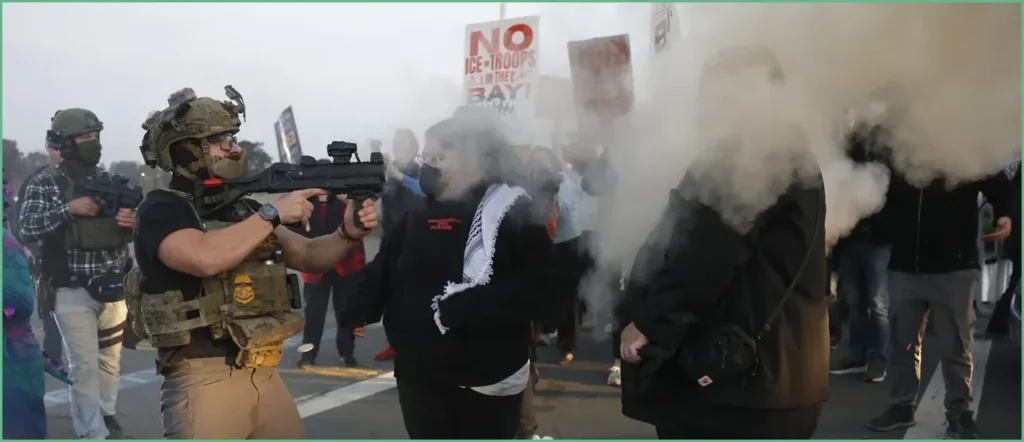The piece recounts a clash between immigration agents and anti-ICE demonstrators in Chicago where federal officials say rocks and commercial fireworks were thrown, and civil liberties lawyers argue that crowd control gas was an unlawful response. It covers the DHS account of the confrontation, the ACLU-backed court filing challenging the use of chemical munitions, and the legal fight over a prior court order that limited such tactics. It also lays out the competing narratives about safety, press access, and what courts should allow when agents face real danger.
Federal officials say the confrontation began when protesters intentionally blocked a road and then escalated into physical attacks on agents, including objects being hurled and commercial fireworks fired at officers. The Department of Homeland Security reported that agents received repeated warnings before crowd control munitions were deployed to stop the advancing crowd. DHS shared the incident details publicly in a post and the claim has become central to the dispute over whether the response was justified .
Local attorneys and civil liberties groups immediately challenged the tactic, arguing in court that the use of gas was “without justification” and violated an existing judicial order. The filing pointed to images and recordings from the scene that paint a chaotic picture, and it accused law enforcement of sweeping tactics against demonstrators and journalists. “ [We] wanted to bring it to the Court’s attention as soon as possible given the flagrancy of the apparent violation,” attorneys wrote Thursday, asking Obama-appointed U.S. District Judge Sara Ellis to take any action she “deems proper.”
Video from the scene, described in court papers, shows a crowd confronting agents, shouting at them and at times moving toward their positions, while a separate image was cited that allegedly shows an official throwing a silver canister. The filing linked to roughly a dozen minutes of shaky footage that lawyers say prove excessive force, and the exchange in that footage is now part of the record. Observers of the tape can see the moments before and after munitions were used and judge for themselves whether officers were under immediate threat .
Border officials say the escalation was not spontaneous but deliberate, with protesters surrounding agents, using a vehicle to box them in, and continuing to advance after warnings were issued. DHS reported that an agent suffered a head injury when struck by a thrown object, which undercuts the notion this was a peaceful, nonviolent assembly. When officers face projectiles and commercial-grade fireworks, the calculus shifts from crowd management to survival.
Lawyers for the protesters insist the order banning chemical munitions should limit agents except under the most narrow circumstances, and they argue this incident did not meet that threshold. That legal view treats police lines as sacrosanct and downplays the real harms that thrown objects and explosive devices can inflict. From a law-and-order perspective, any restriction that leaves agents exposed while protests turn violent is a danger to both officers and the public they protect.
The ACLU-backed suit accuses federal officials of trampling First Amendment rights and subjecting journalists to a pattern of brutality at demonstrations, claims that resonate with some on the left. But rights do not extend to throwing rocks and firing artillery-style fireworks at people, and the presence of press does not legally shield violent tactics by participants. When protesters cross the line into assault, the state has both the authority and the duty to stop them.
Courts now face a straightforward question: does the prior order allow exceptions when the safety of officers is clearly at risk, or does it tie law enforcement’s hands even in the face of direct assault? The order itself includes exceptions for danger to agents, a fact that should weigh heavily in any judicial review. Judges should be careful not to set a precedent that requires officers to choose between obeying a court order and protecting their own lives.
Beyond the specific case, there is a policy angle about how to handle protests that become violent and how to balance civil liberties with public safety. Allowing mobs to test federal agents with impunity invites more of the same behavior, which will always lead to escalation and the eventual use of force when warnings fail. Public officials and judges who want safer streets should support clear rules backing officers who act to protect themselves and civilians.
Media organizations and press freedom advocates have a role, but their claims must be grounded in facts, not assumptions about officer intent. Journalists covering such events should not act as shields for those who choose to riot or assault. Honest reporting should call out violence where it occurs and make distinctions between peaceful demonstration and criminal behavior that threatens lives.
The legal fight opened by protesters and their allies will test how courts interpret protection orders in charged public settings, and how much leeway officers have when facing dangerous conduct. Republicans and others who favor strong law enforcement will argue that prevents-of-harm exceptions must be honored so agents can do their jobs without fear of being second-guessed mid-crisis. The coming rulings will matter for how federal officers are allowed to respond the next time a crowd turns violent.
